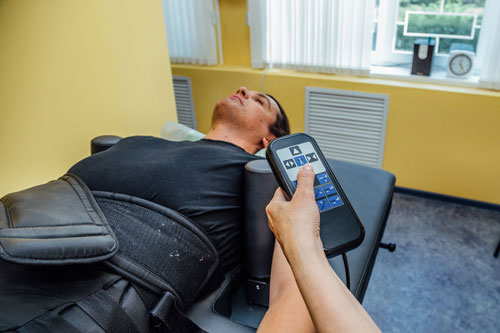Spinal Decompression – What is It and How Does It Work? [Infographic]
With millions of people suffering from chronic lower back pain, spinal decompression could be the painless treatment option you’ve been looking for!
Is Spinal Decompression Right for You?

As the leading cause of job-related disability, sufferers of chronic lower back pain know how damaging the condition can be to their quality of life. While there are numerous treatment options available, many patients still have difficulty finding relief from their pain. For these patients, spinal decompression therapy could be a viable option! Read on to learn more about this powerful treatment and how it can benefit you.
What is spinal decompression therapy?
Spinal decompression therapy uses similar methods that chiropractors, osteopaths, and other healthcare providers have been practicing for years. It’s a painless, noninvasive treatment that uses traction (movement) to pull on the spine gently. This mild movement creates negative pressure between vertebrae in the spine to reposition bulging or herniated discs and soothe other conditions. This decrease in pressure also allows a flood of nutrient-rich fluids to wash over inflamed discs and promote healing.
Usually, doctors recommend spinal decompression when other forms of therapy like massage, chiropractic, and physical therapy haven’t relieved symptoms. It’s used to treat those suffering from degenerative disc disease, chronic neck pain, frequent headaches, sciatica, and many other conditions. If you’re unsure if your symptoms can be treated with spinal decompression, reach out to your chiropractor to see what he or she recommends.
How does it work?
During a typical session, patients lie fully clothed on top of a motorized table. In most cases, patients lie on their backs, but some procedures might have them faced down in a prone position. A brace is fitted snugly around
the patient’s torso, which protects the spine’s stability. Then, the brace attached to the movable lower-half of the table. While this lower-half slides forward and back to provide traction for the spine, the upper-half remains fixed to support the head and shoulders.
Your health care practitioner may combine your spinal decompression session with other types of treatments. These might include electrical stimulation, ultrasound, and heat or cold therapy. Your chiropractor will be able to help you find the best combination of treatments for your unique condition.
What is the timeline?
For best results, patients can typically expect to receive 15-20 sessions over the course of four to six weeks. Sessions can last between 30-45 minutes and should not be painful, although patients will feel moderate stretching sensations. While there is no precise timeline, many patients report significant relief from their symptoms by the fifth or sixth visit. Other patients even experience total relief from their pain at the time of their decompression. But every patient is different, so it might take longer for some patients to see results from spinal decompression therapy.
Who should avoid spinal decompression therapy?
Spinal decompression therapy can hugely beneficial in treating chronic pain and other conditions. But some people might want to avoid it. Pregnant women experiencing lower back and leg pain shouldn’t seek out spinal decompression as it could put it the baby at risk. Likewise, patients with broken vertebrae, spinal fusion, or metal implants should also seek out other forms of treatment.
Want to know more?
Spinal decompression therapy can be a highly effective, noninvasive alternative to painful and potentially disruptive surgical procedures. If you want to learn more, contact the Algonquin Chiropractic Center in Algonquin, Illinois today to set up a consultation.

